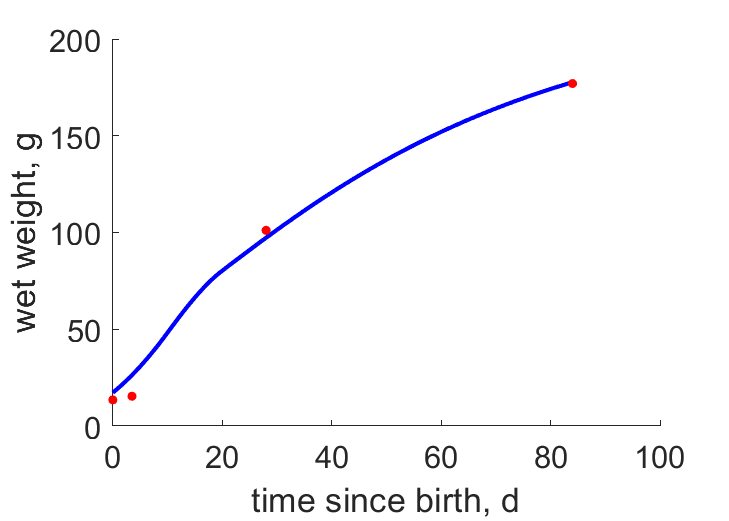Predictions & Data for this entry
| Model: std | climate: A | migrate: | phylum: |
| COMPLETE = 2.5 | ecozone: THn, TN | food: biCi, biHl | class: |
| MRE = 0.041 | habitat: 0iFm | gender: Dg | order: |
| SMSE = 0.004 | embryo: Tnffm | reprod: O | family: |
Zero-variate data
| Data | Observed | Predicted | (RE) | Unit | Description | Reference |
|---|---|---|---|---|---|---|
| ab | 23.5 | 24.02 | (0.02223) | d | age at birth | avibase |
| tx | 63 | 62.65 | (0.005628) | d | time since birth at fledging | avibase |
| tp | 189 | 170.1 | (0.1001) | d | time since birth at puberty | guess |
| tR | 365 | 365 | ( 0) | d | time since birth at 1st brood | avibase |
| am | 2664 | 2691 | (0.009946) | d | life span | avibase |
| Ww0 | 18 | 17.82 | (0.009731) | g | initial wet weight | avibase |
| Wwb | 13.4 | 12.65 | (0.05568) | g | wet weight at birth | WestHess2020 |
| Wwi | 215 | 243.8 | (0.1337) | g | ultimate wet weight | avibase |
| Wwim | 257 | 256.4 | (0.002434) | g | ultimate wet weight of male | avibase |
| Ri | 0.01781 | 0.01727 | (0.03009) | #/d | maximum reprod rate | avibase |
Uni- and bivariate data
| Data | Figure | Independent variable | Dependent variable | (RE) | Reference |
|---|---|---|---|---|---|
| tW |  | time since birth | wet weight | (0.06269) | WestHess2020 |
Pseudo-data at Tref = 20°C
| Data | Generalised animal | Porphyrio martinica | Unit | Description |
|---|---|---|---|---|
| v | 0.02 | 0.02852 | cm/d | energy conductance |
| p_M | 18 | 474.5 | J/d.cm^3 | vol-spec som maint |
| k_J | 0.002 | 0.01974 | 1/d | maturity maint rate coefficient |
| k | 0.3 | 0.304 | - | maintenance ratio |
| kap | 0.8 | 0.5991 | - | allocation fraction to soma |
| kap_G | 0.8 | 0.8017 | - | growth efficiency |
| kap_R | 0.95 | 0.95 | - | reproduction efficiency |
Discussion
- Males are assumed to differ from females by {p_Am} only
- mod_1: Pseudo-data point k is used, rather than k_J; Data set tp and parameter t_R are added, the latter replacing clutch interval t_N. Postnatal T is based on PrinPres1991, see get_T_Aves. See further the revision page, theme puberty
Bibliography